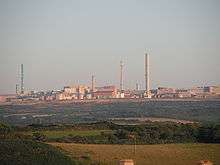La Hague site
The La Hague site is a nuclear fuel reprocessing plant at La Hague on the Cotentin Peninsula in northern France, with the Manche storage centre bordering on it. Operated by Orano, formerly AREVA, and prior to that COGEMA (Compagnie générale des matières atomiques), La Hague has nearly half of the world's light water reactor spent nuclear fuel reprocessing capacity.[1] It has been in operation since 1976, and has a capacity of about 1700 tonnes per year. It extracts plutonium which is then recycled into MOX fuel at the Marcoule site.

It has treated spent nuclear fuel from France, Japan, Germany, Belgium, Switzerland, Italy, Spain and the Netherlands. It processed 1100 tonnes in 2005. The non-recyclable part of the radioactive waste is eventually sent back to the user nation. Prior to 2015, more than 32,000 tonnes of spent nuclear fuel has been reprocessed, with 70% of that from France, 17% from Germany and 9% from Japan.[2]
History
.jpg)
The La Hague site was built after the Marcoule site originally for producing plutonium for military purposes. In 1969 the French military, having had a sufficient supply of plutonium for weapons, had no further use of the reprocessing centre. The factory directed its efforts toward civil operations, and with the reduction of 350 people from the plant's workforce, its military connections ended.
This shift to civil uses was supported by Valéry Giscard d'Estaing and strengthened by the 1973 oil crisis.
In the late 1990s, the facility was criticized by Greenpeace who drew attention to its radioactive emissions to the atmosphere and marine environment.
On 5 October 2002, an INES Level 1 incident occurred at La Hague. A sub-contractor working at the plant suffered skin contamination while rinsing equipment in the plutonium purification workshop.[3]
Controversy surrounding radioactive releases
Greenpeace has been campaigning since 1997 for the shutdown of the site, which they claim dumps "one million litres of liquid radioactive waste per day" into the ocean; "the equivalent of 50 nuclear waste barrels", claiming the radiation affects local beaches.[4][5] Although official figures are to the contrary.[6] Greenpeace have also protested by creating roadblocks and chaining themselves to vehicles transporting materials to and from the site.[7][8] However the leader of Greenpeace France, Yannick Rousselet, has since stated that they have ceased attempting to criticize the reprocessing plant on technical grounds, having succeeded at performing the process without serious spills that have been frequent at other such facilities around the world. In the past, the antinuclear movement argued that COGEMA would not succeed with reprocessing.[9] Eric Blanc, deputy director of the processing plant, says that although the plant does intentionally release radioactive material, the annual dose in the vicinity of the facility is less than 20 microsieverts per year, which is equivalent to the dose of cosmic radiation received during a single transatlantic flight, and therefore within regulation.[9] The AREVA NC website emphasizes that they are committed to keeping the dose below 30 microsieverts per year.[10]
See also
- Sellafield, a similar facility in the United Kingdom
References
- Kok, Kenneth D. (2010). Nuclear Engineering Handbook. CRC Press. p. 332. ISBN 9781420053913.
- Emmanuel Jarry (6 May 2015). "Crisis for Areva's plant as clients shun nuclear". Moneyweb. Reuters. Retrieved 6 May 2015.
- "NUCLEAR SAFETY: WORKER CONTAMINATED IN INCIDENT AT LA HAGUE PLANT". Europe Environment. 2002-12-13. Archived from the original on 2016-05-06. Retrieved 2015-05-02 – via Highbeam Research.
- "Greenpeace installs webcam at the end of France's nuclear reprocessing discharge pipe 'to open the eyes of Governments'". Greenpeace website archive. 2000-06-26. Archived from the original on 2007-06-14. Retrieved 2007-08-26.
- "Areva NC discharge pipe - Collection of related press releases". Greenpeace website archive. Archived from the original on 2007-08-28. Retrieved 2007-08-26.
- "La Hague - France Nuclear Forces". GlobalSecurity.org. Retrieved 2007-08-26.
- Naegelen, Jacky (2004-10-07). "US Bomb-Grade Plutonium Convoy to Cross France". Reuters. Archived from the original on 2007-08-03. Retrieved 2007-08-26.
- "Greenpeace blocks top secret transport of plutonium in France, revealing global proliferation threat is not in Iraq". Greenpeace International. 2003-02-19. Archived from the original on 2007-12-02. Retrieved 2007-08-26.
- Fairley, Peter (February 2007). "IEEE Spectrum: Nuclear Wasteland". Archived from the original on 2007-02-16. Retrieved 2007-08-26.
- "Zero impact commitment". AREVA NC. Retrieved 2007-08-26.